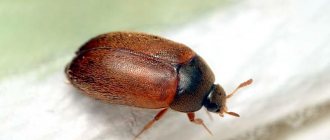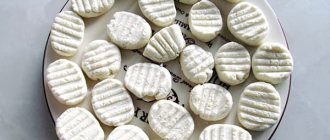The appearance of any type of insects in the apartment causes a lot of trouble for the owners. In addition to their unpleasant appearance, which you can judge from the photo, they can cause significant damage to products, items made of fur, wool, leather, as well as furniture and even books. One common kitchen bug is the bread grinder. This pest feeds on food supplies, especially loves flour and flour products, cereals, dried fruits, tea, tobacco, medicinal herbs and even animal food.
You can distinguish the bread borer from another type of beetle by its oblong brown body, 2-3 mm in size, covered with hairs. Its larvae have a curved shape and reach 5 mm in length. Both adults and their larvae can cause damage to products. They make holes in their food, eating everything that gets in their way. Therefore, if you find small holes in bread that resemble passages, there is no doubt that the presence of a grinder beetle is present.
What does a bread grinder look like: photo
Bread grinder.
Bugs in flour and cereals: what to do?
In a year, the grinder beetle is capable of producing one or two generations; in heated rooms, fertility is higher - up to five generations. Visually tidy cabinets are not an indicator that they are pest-free. When food is slightly infested, the vital activity of insects usually proceeds unnoticed, inside the food substrate.
With a high population density, bugs in flour and cereals are forced to crawl out in search of new habitats, so they can easily be found on the surface of contaminated food. The bread grinder can get inside the premises with purchases, in bags of cereals and flour, or through cracks in frames and window vents. If there are bugs in the cereal, what should you do? How to get rid of unwanted pests once and for all?
The bread grinder flies perfectly; in the evening, like butterflies, it gathers in flocks near a light source. In apartments they can often be found on window sills.
When you touch it, it freezes, pretending to be dead, or makes very unpleasant sounds.
Description of the beetle
Name: Bread grinder Lat.:
Stegobium paniceumClass: Insects - Insecta Order: Coleoptera - Coleoptera Family: Grinders - Stegobium
| Habitats: | almost everywhere around people |
| Dangerous for: | food supplies, provisions |
| Means of destruction: | cleaning, fumigation |
"Hairy" grinder.
The body of the bug has an oblong shape with rounded edges, and the color can vary from light brown to brown, with a reddish tint. The length of an adult insect usually does not exceed 1.7-3.8 mm.
The entire surface of the bread grinder's body is densely covered with short, brown hairs. Sexual dimorphism of females and males is practically not expressed and their only external difference is the slight superiority of males in size.
Habitats and breeding characteristics
If you come across at least one pest, you should conduct a thorough inspection of your food supplies. Favorite habitats are:
- pasta;
- cereals;
- baked goods, cookies, waffles, sugar, candies and other confectionery products;
- coffee, tea, cocoa;
- dried fruits;
- animal feed, including poultry and fish;
- tobacco and cigarettes;
- dry herbal mixtures;
- books.
Complete disposal of the beetle can only occur if the location of its settlement is discovered. In fact, it is not difficult to identify it; you just need to carefully examine the products and other places where it may be located. Small holes are often found in the food, leading to labyrinths where not only beetles, but also larvae live. If the grinder has settled in books or boxes, then the entire surface will be strewn with fine dust. He eats some of the paper, and grinds some into dust.
Almost any product or item can be suitable for these pests. They especially love things that have been lying around for a long time, for example, packs of old newspapers, dried medicinal herbs, etc. The exception is wood, which the larvae do not touch.
Female bread borers lay an average of 140 eggs in food. They will subsequently become a place of sustenance for the offspring. The larvae look like dirty white worms with several spines on their backs. Their upper jaws are well developed and have small teeth. Later, the larva pupates, being in the same products and creating a cocoon around itself from small food particles.
Adults do not need food; they use up the reserves that they accumulated while they were larvae. But this does not stop them from spoiling food by making passages in it to get out.
Products damaged by grinder beetles should never be eaten, as they contain their waste products. This can cause allergies and even poisoning. It is best to throw away such food, or feed it to the birds.
Development cycle of a bread grinder
In residential areas, these harmful bugs successfully live and reproduce all year round, but in the natural environment they are found only in the first half of summer.
The fertility of one adult female can reach 60-80 eggs, which she lays directly in containers with cereals, cookies, dried fruits or other suitable products.
After 10-15 days, larvae emerge and immediately begin destroying food supplies.
Grinder larva.
Depending on temperature conditions, the bread borer can spend from 1 to 5 months in the larval stage. All this time the larva feeds, grows and goes through 4-5 molts. After the larva has stored enough nutrients, it pupates.
The emergence of the imago from the pupa occurs approximately on the 12-18th day. An emerging adult grain borer can live from two weeks to two months, depending on external conditions.
The full development cycle of insects of this species takes from 70 to 200 days.
Preventive measures
There are a number of simple measures that can help prevent the appearance of a bread grinder in your home:
- if the quality of the purchased cereals is in doubt, they need to be dried in the oven for 8-10 minutes. They should be stored in jars with well-closing lids;
- It is advisable to store containers with cereals on shelves where sunlight penetrates - in case of infection, it inhibits the development of pest eggs;
- you need to pour cereal into jars only after a thorough inspection;
- It is important to keep the kitchen clean and periodically clean out the cabinets;
- Pests are well repelled by cloves of garlic or salt placed in a rag bag, which are placed in jars or bags of cereal. In addition, bay leaves can be laid out on the shelves, the smell of which grinders cannot stand;
- You should not buy excessive amounts of flour and cereals for future use;
- nuts, dried fruits and bread are best stored in the refrigerator;
- When storing bulk products in fabric bags, they should first be washed in a concentrated soda solution.
Habitat of bread grinders
Initially, this type of beetle lived exclusively within the Palaearctic, but over time it spread and adapted to life almost everywhere. The bread grinder can be found even in the harsh climate of northern latitudes, where insects have settled near people. The favorite habitats of grinders were and remain:
- food warehouses;
- bakeries;
- bakeries;
- the shops;
- warehouses with finished products;
- residential buildings and premises.
What is the harm of an insect?
In nature, the grinder feeds on rotten wood, dry and limp grass, and rotten fruit. But when it gets into a human home, it happily eats food and some other objects.
The insect can parasitize on:
- any bakery products;
- books;
- medicinal herbs;
- medicinal powders, tablets;
- grain and other pet foods;
- herbariums;
- entomological collections.
The larvae located in the nutrient substrate molt. This happens 4–5 times throughout their entire existence at this stage. Discarded chitinous covers contaminate food and medicinal herbs. They can cause an allergic reaction or poisoning. The larvae also leave excrement. They may also be unsafe for the human body.
The bread borer can carry various pathogens of infectious diseases. The insect can infect food with them.
If we are talking about books, then the beetle larva completely renders them unusable, gnawing tunnels between the pages.
Although the imago does not have a mouthpart, an adult insect is also capable of damaging food and other things. The fact is that before laying eggs, the female breaks through or gnaws a deep hole in the nutrient material in order to ensure the greatest safety for the offspring.
How to get rid of bread grinders
To completely get rid of bread grinders, you need to put in a lot of effort. Only an integrated approach and the following actions will help you cope with the pest:
- All products infected with the pest should be thrown into the trash, and the containers in which they were stored should be soaked in soapy water and rinsed thoroughly.
Bread grinder in stock.
- All surfaces must be treated with a liquid insecticide or one of the disinfecting folk remedies.
- Eliminate all cracks in the floor and walls.
- Always use mosquito nets on windows in summer.
- All products purchased after processing should be stored exclusively in glass or plastic containers with a tight-fitting lid.
Prevention
Once the necessary measures have been taken to eliminate the borer beetle, care should be taken to ensure that it does not appear again. For this it is important:
- Store cereals and other bulk products in tightly closed containers. And also get rid of cardboard boxes and paper bags.
- Try not to accumulate large stocks of food at home, but purchase them only as needed.
- Before purchasing, carefully inspect groceries, flour, and cereals for holes, dust, beetles, and larvae.
- Before pouring the purchased product into a container, you need to rinse and dry it in the oven.
- You can keep food in the freezer for a day, for example, bread.
- Periodically inspect kitchen cabinets.
- It is best to store baked goods, dried fruits and nuts in the refrigerator.
- Wipe the surface of the countertop and sink dry if not in use.
- Cover the ventilation holes with fine mesh.
- It is better to wash dishes immediately after eating, and put uneaten food in the refrigerator.
- Maintain cleanliness in the kitchen and apartment.
It is better to take preventative measures and prevent the appearance of grinder beetles than to later get rid of annoying pests that can cause a lot of damage to food and other things.
Unfortunately, the bread grinder is not a rare occurrence both in the apartment and in the house. Its occurrence always causes a lot of concern among owners, since it indicates spoiled food, books, newspapers or other things. The success of pest control depends on the thoroughness of the search for its habitat, as well as subsequent treatment and the necessary prevention.
Damage caused
Beetles can ruin a lot of food in the house or in a warehouse, since it is not so easy to identify the borers right away; they usually catch your eye when there are already a lot of them.
Important ! If food is contaminated by bread grinder, it should be thrown away. Otherwise, both people and animals are at risk of food poisoning from beetle waste, allergic manifestations, and eating disorders. Contaminated products are not harmful to birds, so those in which traces of beetles were found can be given to birds, be they domestic or wild birds, without fear.
Food spoilage
Malicious activities of the beetle grinder
A bread grinder can ruin almost all products: flour, bread, cereals, crackers, tea, pasta. Does not disdain herbariums and dried herbs, even poisonous ones: belladonna, strychnine, ergot, aconite. If you carefully search, the grinder beetle can be found on bookshelves, where the larvae diligently destroy paper, turning it into fine dusty dust. In the library environment, the insect is called the “book bug” for such pestilence. The kitchen dweller can even get into cigarettes. The insect is not interested in wood, so there is no need to worry about wooden floors, walls and furniture.
How to get rid of grinder beetles? Unlike the fast cockroach, darting around the kitchen in search of food, the bread grinder is a permanent insect. Having found a suitable product, the beetle firmly settles in it and begins to actively reproduce. The pest can be identified by the spoiled appearance of perforated products, the presence of dust and excrement in them. Grinder larvae are clearly visible in the breeding area.
Why do bugs appear?
First, let's figure out where beetles come from, because they can often be found in kitchens where perfect order reigns. Insects enter the house through open windows and cracks in them. They can also be brought into the house along with contaminated products (for example, low-quality cereals).
For their habitat, beetles choose places with a large amount of easily accessible food; they often settle in dry trees. Poorly closed bags of cereals and flour attract them like a magnet. Pests will not refuse pasta, nuts, and dried fruits. They attack spices, sweeteners, and can settle in teas and coffee.
Although beetles do not carry diseases, they make life very difficult for the owners of the house in which they live
It is important to detect the presence of insects in time, otherwise they will scatter to other rooms. This is especially true if you eat outside of the kitchen and have a habit of accumulating dirty dishes (cups by the bed also count)
Delay in this case is fatal: bugs can be found among fabrics, papers, and furniture.
And a little more about prevention
The following tips may be helpful:
- Buy food in small quantities so that you can use it in no more than 2-4 months. Try not to store food longer than this period.
- Use products from older (or opened) packages that were previously freshly purchased/closed.
- When purchasing packaged foods, check the integrity of the packaging and, if possible, the presence of insects.
- Remember that cardboard, foil, paper or plastic bags will not prevent insects from breeding.
- Keep food storage areas clean and do not allow crumbs or food particles to accumulate, as stale food will attract insects. Cleanliness is especially important in animal feed storage areas.
If bugs appear in the kitchen again, check other rooms in the apartment for breeding sites and repeat the described steps. If your pest problem persists, seek help from a home pest control professional.
Ways to scare away living creatures
It will not be possible to save contaminated products. Therefore, the main method of combating parasites is prevention. To prevent critters from appearing, follow three recommendations.
- Dry. This rule applies to loose products. After bringing them from the store, dry them in the oven at low temperature for half an hour.
- Freeze. In this case we are talking about packaged cereals. The package can be placed in the freezer for a day. Then pour the contents into a special container and put it in the closet.
- Pour boiling water over it. And wash it. This is how dried fruits should be processed. And then it is best to keep them in the refrigerator.
There are also a number of popular tips on how to store cereals so that bugs do not appear.
- Garlic. Place an unpeeled garlic clove in the jar with the product. You can also display the heads on shelves in cabinets.
- Pepper. In particular, hot pepper pods. Some housewives replace it with dried lemon zest.
- Salt. Two or three teaspoons of salt wrapped in gauze at the bottom of the container with the product will help protect the contents from pests.
- Metal. Bugs are afraid of metal, so a spoon or foil at the bottom of the jar will get rid of dangerous guests.
Before purchasing any bulk products, you must inspect the packaging. If it is damaged or there is the slightest sign of insect infestation, refuse to purchase. Even if the price is attractive, promotional.
Pest control methods at home
Getting rid of insects that have settled in your home is not easy, so get ready for a stubborn struggle.
The main methods of eliminating “uninvited guests” can be divided into the following groups:
- mechanical impact;
- chemicals;
- folk remedies.
Mechanical impact
Before carrying out procedures of this nature, you first need to get rid of contaminated products so that they do not harm your health. Containers and storage areas should be thoroughly washed with soap (dishes) or vinegar solution (cabinets, shelves).
It will not be superfluous to seal all the cracks in the baseboards, window sills and furniture. The remaining products, untouched by pests, should be packaged and taken outside the kitchen for 1–2 weeks. If the bugs do not appear, then you can use them.
When the number of bugs is minimal and they are quickly detected, you can try to save the remains of the cereal using heat treatment:
- heat the product in the oven at a temperature of 50 o C (for semolina and flour) or 100–120 o C (for other grains) for at least 10 minutes;
- expose cereals to low temperatures (-15 o C) for 24 hours;
- treat with ultraviolet light, placing it under the sun for several hours.
Before processing, it is necessary to sort out the grain products or sift them through a sieve, and then, before consumption, soak them in salt water and rinse.
Chemicals
It is advisable to use chemicals to kill insects in extremely advanced cases, when other means (including folk remedies) are not able to solve the problem.
The most harmless product that can be purchased at any pharmacy is pyrethrum powder.
They are sprinkled on food storage areas. The product is absolutely non-toxic for animals and people (even if accidentally ingested), but it is poisonous for crawling insects.
You can wash the cabinets with Domestos solution or another chlorine-containing product. It is advisable to repeat this procedure several times, since the effectiveness of a single use of this “weapon” to combat beetles is low.
“Anti-bug” is an impregnation that is used to protect wooden surfaces from the actions of grinders. Hazardous to humans if in contact with eyes or skin.
Remedies are intended for treating wood, but at the same time they are poison for mucoeds. But neither humans nor pets should breathe them.
Rogneda brand products will get rid of not only bugs, but also cockroaches and ants. When using, personal protective equipment must be used.
It should be noted that chemical control methods are not always the most effective. It is impossible to treat surfaces in contact with food and feed with drugs; moreover, they have a lot of side effects.
Folk remedies
To get rid of pests, sometimes it is enough to have the following ingredients available:
- vinegar;
- Bay leaf;
- nutmeg;
- garlic;
- lavender;
- sagebrush;
- borax.
You can prepare special bait traps for bugs. On shelves or in cabinets, you need to sprinkle nutmeg on an adhesive plaster, put peeled garlic cloves, bay leaves, or add these spices to containers for flour and cereals, after wrapping them in gauze. Another trap is made using sugar, borax and dry yeast, which are mixed in equal proportions. The resulting composition should be laid out on pieces of paper in cabinets, which will lure the bugs out of their hiding places.
There is an opinion that small pests cannot tolerate the smell of metal. By putting a nail, wire or just a piece of foil in a jar of cereal, you will get rid of annoying “visitors”.
You can use vinegar solution to wash food storage areas. Dried twigs or essential oils of lavender or wormwood are wonderful remedies against food moths.
Takes ~3 minutes to read
Cereal dishes are among the most popular in the daily diet. Many housewives prefer to purchase cereals in large quantities in order to always be ready to prepare this or that dish. But such thriftiness can backfire if insects take up residence in the reserves.
If bugs appear in the cereal, how to get rid of them will be a matter of first importance. How to deal with uninvited guests, and what to do to prevent their appearance?
Why you shouldn't eat contaminated foods
When food is infested with insects, continued consumption may be dangerous. If there were few bugs, then drying and sifting the cereal or flour will eliminate all problems with its quality. But, when the infection was significant, the bugs destroy large volumes of useful substances in the product, including proteins, and instead leave the remnants of their own vital activity:
- excrement;
- chitinous plates;
- cocoons from larvae.
The taste characteristics of such a product are significantly reduced, as is its usefulness for the body. Flour, after being infected by a flour eater, can completely lose its properties - the dough from such a product cannot be kneaded. A negative point is also the risk of food poisoning. It is preferable to throw away products that have been significantly damaged.
If small bugs appear in your home cereal supplies, this is a signal to check the entire food pantry...
Precautionary measures
Simple precautions will help you avoid such an unpleasant problem as kitchen pests
- To prevent bugs from infesting flour and cereals, they must be stored at medium humidity in a well-ventilated area;
- You need to make sure that there are no raw or undried foods (dried fruits, vegetables, wet cereals) in the kitchen cabinets. If there are any, then the mucoed will definitely settle in them;
- It is mandatory to regularly inspect products and shelves. Make sure that cereals do not sit for a long time; long-term storage is the main cause of insects.
- Keep cloves, bay leaves and matches in your kitchen cupboard to repel pests.
- Store cereals and grains in plastic or glass containers with an airtight lid.
- If you notice the first signs of spoilage of food, immediately throw it away or rinse or sift through a sieve.
- Carry out general cleaning at least once a month using disinfectants.
Source: www.tofp.ru










